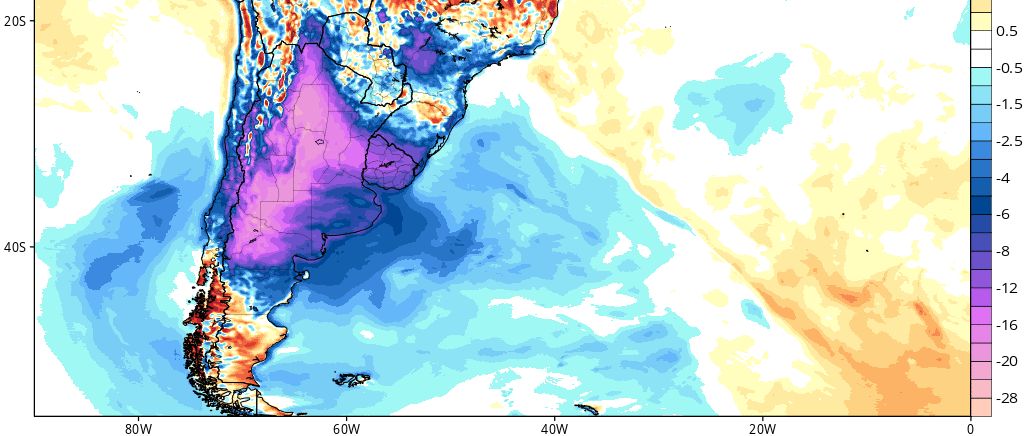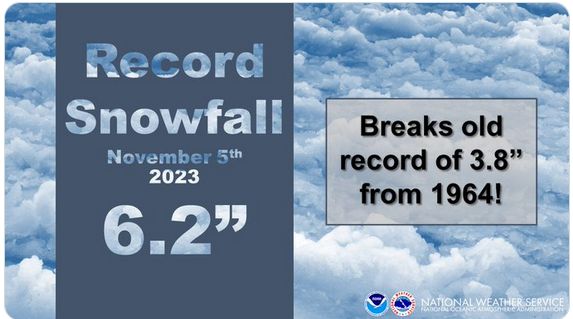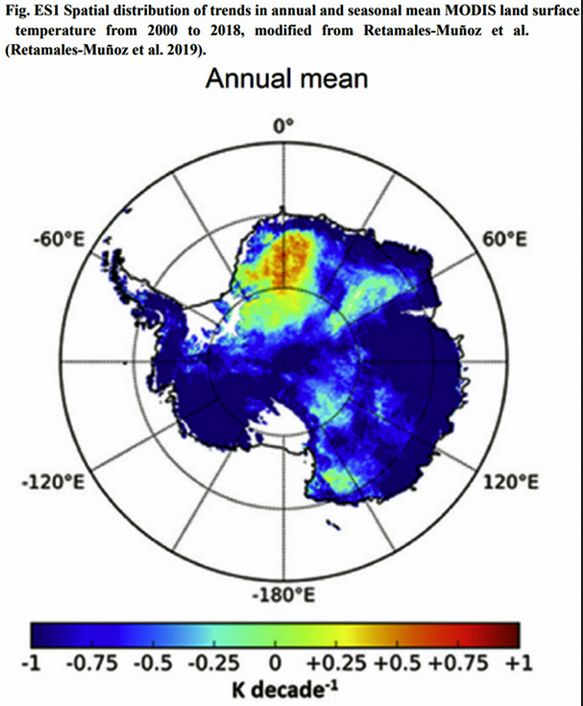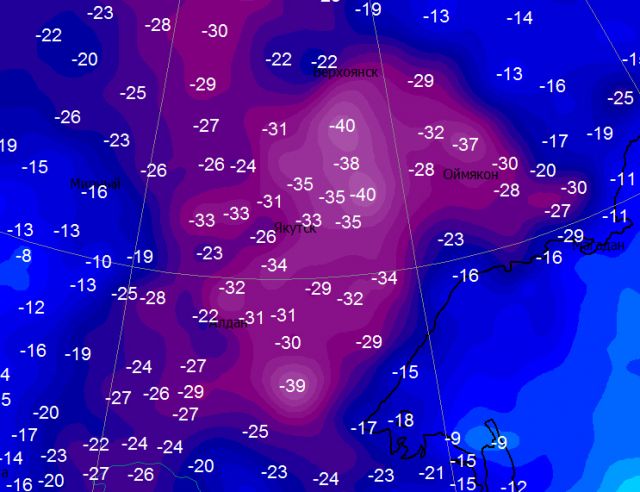Surface temperatures measured where people live show there’s as much cold as there ‘s warmth, see temperature.global.com.
Christian Freuer’s Cold Report (EIKE)
Snowpack extent in US reaches record levels!
America’s first Arctic air blast of the season broke hundreds of low temperature records and led to the largest snowpack extent there in early November in NOAA records.
A high snowpack blanketed the Rocky Mountains, northern Plains, Great Lakes and northern New England, resulting in 17.9% of the Lower 48 under a blanket of snow as the calendar turned to November – a new record in the books dating back to 2003.
Many places recorded their snowiest Halloweens ever.
At 22 inches, Muskegon, MI, not only recorded the snowiest Halloween ever, but also the snowiest October day and month. Glasgow, MT, recorded the snowiest start to the season with 36 inches.
The cold broke hundreds of low temperature records across the country, from Texas to Maine, dropping the average temperature in the Lower 48 to -0.5°C – more than 5 degrees Celsius below normal.
Historic November cold grips Argentina, Australia
A late cold spell has hit large parts of South America, especially Argentina. The country recorded the lowest November temperatures since records began.
A number of records for highs and lows have fallen. New lows include the 0.1°C at Córdoba Airport, which broke the record of 2°C set on November 4, 1992, the 1.6°C in Chamical, which broke the record of 4.5°C set on November 9, 2010, and the 2.8°C in Mendova, which beat the 3.2°C set in 1992.
New lows include Gualeguaychú’s 13.8°C, which broke the old record set in 1992, and Paraná’s 13.5°C, which beat the record set in 1936.
The cold was severe, up to 24 degrees Celsius below normal, and it was also widespread, affecting most of Argentina:
Chart: GFS 2m temperature anomaly (°C) from November 2. [tropicaltidbits.com].
In Australia
While it was really hot in the west, the east was freezing. New November lows fell in New South Wales, including -2.5°C in Young and -0.1°C in Parkes.
Cold October in Uruguay
The South American frost at the beginning of November also hit Uruguay, continuing the anomalously cold October. October 2023 averaged between -0.5 °C and -1 °C below the multi-year norm.
Snowstorm claims the lives of shepherds in Mongolia
Last year, cold and snow disrupted the seasonal migrations of shepherds in northern China, Kazakhstan and Mongolia.
Last November, herders in the northwestern Chinese region of Xinjiang died in the lowest temperatures since the 1980s. Hundreds of cattle and sheep froze to death as snowstorms and temperatures as low as a record -48.6°C blew in from the north.
There is a terrifying Twitter video about this!
The winter capers in China and Mongolia (which appear again in a news item below) also found their way back into the alarmist blog wetteronline.de.
Record snowfall in China
Trains and buses were canceled and schools closed across northern China as the first major snowstorm of the season hit the country. According to the weather service, the cold front is expected to bring record-breaking snowfall.
Major highways in northeastern cities such as Harbin, the capital of Heilongjiang province, are closed and flights have been canceled, according to Chinese state broadcaster CCTV.
Lots of snow in Anchorage
Anchorage also saw its first major snowfall from Sunday to Monday, with more than 15 cm falling on November 5 alone.
According to the National Weather Service, this was the most fresh snow ever to fall in the city on November 5. The previous record of 10 cm from 1964 was thus clearly surpassed.
Source: Twitter-Video
New study: Antarctica cools more than 1°C since 1999
Significant cooling in the 21st century in the Central Pacific, East Pacific and almost the entire Antarctic “implies considerable uncertainties in the future temperature projections of the CMIP6 models”. – Zhang et al, 2023
As reported by notrickszone.com, new research indicates that mean annual temperatures in West Antarctica fell by more than -1.8°C between 1999 and 2018. The cooling was most pronounced in spring, with the West Antarctic Ice Sheet (WAIS) cooling at a rate of 1.84°C per decade.
According to the results of Zhang et al., most of the Antarctic continent has cooled by more than 1°C in the last two decades. See, for example, the cooling trend of ~1 °C per decade for East Antarctica (2000 to 2018) shown here:
Link: https://electroverse.info/
One meter of early-season snow in the Alps
It has snowed heavily in the European Alps this week. “It’s looking good,” reports planetski.eu.
Snowfall amounts have exceeded one meter in some areas, with the zero degree line dropping to 1,500 meters.
High levels have been recorded in the northern French Alps, such as the ski resorts of Tgnes, Le Arcs, La Rosiere and Chamonix, while in the western Swiss Alps Glacier 3000 and Verbier, as well as Courmayeur and La Thuile in north-western Italy, have recorded incredible early winter levels.
Numerous European ski resorts have already opened their slopes: 2 in Finland, 1 in Norway, 7 in Austria, 3 in Italy and 3 in Switzerland. More ski resorts were due to open this weekend, including Verbier in Switzerland (on Fri, November 10).
Operators in France are also preparing for an early opening, as the number of requests has increased following the heavy snowfall.
90% of Russia covered by snow
According to the scientific director of the Russian Hydrometeorological Center Roman Vilfand, 90% of Russia is covered in snow.
All of Siberia and the south of the Urals are covered with snow, including Transbaikalia; in the Khabarovsk Territory and Primorye there is an average of 20 cm of snow; on Sakhalin it is up to 8 cm.
Most of Karelia is covered in snow, as is the northern half of the Arkhangelsk region, including Arkhangelsk itself; snow has been accumulating in the Komi Republic for a long time, while in the north of the Perm Krai the snow cover persists.
On the European side, the border of the snow cover runs north of Moscow and St. Petersburg, according to a report by hmn.ru.
“Now we can say that 90% of the territory is covered in snow,” said Vilfand to illustrate the situation.
More record-breaking snow in China
A record-breaking early snowfall has hit northeast China this week, leading to flight cancellations, road closures, train cancellations and school closures.
According to a senior meteorologist at the National Meteorological Center, the first snowfall in northeast China usually occurs between late November and early December, so this week’s snowfall came exceptionally early.
Harbin issued a very rare “red” blizzard warning – the highest in China’s four-tier warning system.
Heavy snowfall hit a number of Chinese provinces, causing widespread disruption.
China’s National Meteorological Service has issued an orange blizzard warning for the provinces of Jilin, Heilongjiang and Inner Mongolia.
The lingering cold is the next problem and workers are now scrambling to restore power and clear snow-covered roads.
This is a ‘proper’ early winter Arctic storm – no wonder the western media won’t touch it.
–40°C in Russia
Following the news that 90% of Russia is covered in snow [see above], the low temperatures are also making an early and ubiquitous appearance.
“The Russian winter is taking its course”, reports gismeteo.ru.
The first -20 °C of the season were measured in Russia on October 11, and the first -30 °C were recorded on October 17.
And now the continental cold has reached a new peak: -40°C.
Last weekend in the Tuguro-Chumikansky district of the Khabarovsk Territory it was -40°C. This weather is considered “very cold” even in the depths of winter, let alone in early November, even by Russian standards.
The cold was not an isolated case either: on November 7, -40 °C was also measured in Tomponsky Ulus in Yakutia:
Source. Gismeteo
According to Gismeteo, this frost will not disappear. On the contrary, it will intensify in the coming days and spread to new areas.
Compiled by Christian Freuer for EIKE.
Also see Electroverse.










Electroverse.com is now Electroverse.info
Looking for -50°C ( -58°F.):
https://arctic-russia.ru/en/article/yakutia-a-journey-into-the-cold/
“According to Yakut legends, it is at the Pole of Cold that Chyskhaan lives—the Lord of Cold and the keeper of the permafrost, who creates winter with his icy breath. He wears a blue aurora borealis patterned fur coat and a high-horned fur hat.
. . . Yakutia—you can hear your own breathing. The sound of a freezing exhalation even received a special name: it is called the “whisper of the stars”.
[…] vilket kanske kan ge ett visst perspektiv på alla uppvärmningslarm som vi annars bombarderas med https://notrickszone.com/2023/11/15/while-media-obsess-about-warmth-globe-seeing-plenty-of-unusual-c… . Här är ett stycke om Antarktis från en tidigare studie (se även här […]
[…] From the NoTricksZone […]
[…] From the NoTricksZone […]
[…] From the NoTricksZone […]
[…] From the NoTricksZone […]
[…] The BBC concludes that the “devastating climate impacts currently being experienced” highlight the challenges the world is already facing. These “devastating impacts” are of course little more than a dot-joining exercise with a number of recent climate anomalies. Needless to say, most of these involve heat, so there is little room for all the cold records that have occurred in 2023. In the interests of balance, it might be briefly noted that Argentina has just recorded its lowest November temperatures since records began, including 0.2°C at Cordoba Airport. Huge amounts of snow in parts of Europe have led to early starts in the skiing season in the French Alps. Further details of these records, and many others, ignored by mainstream media, can be seen here. […]